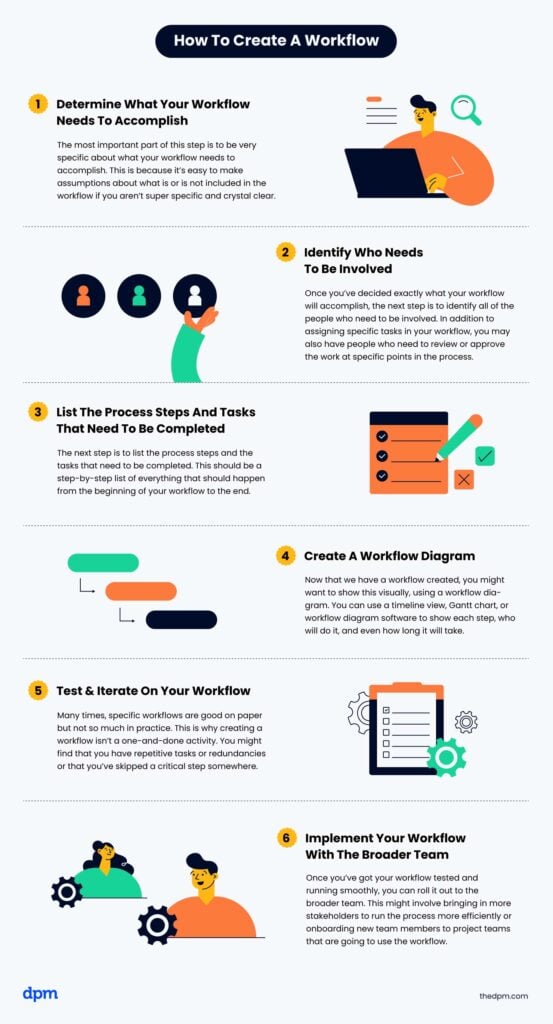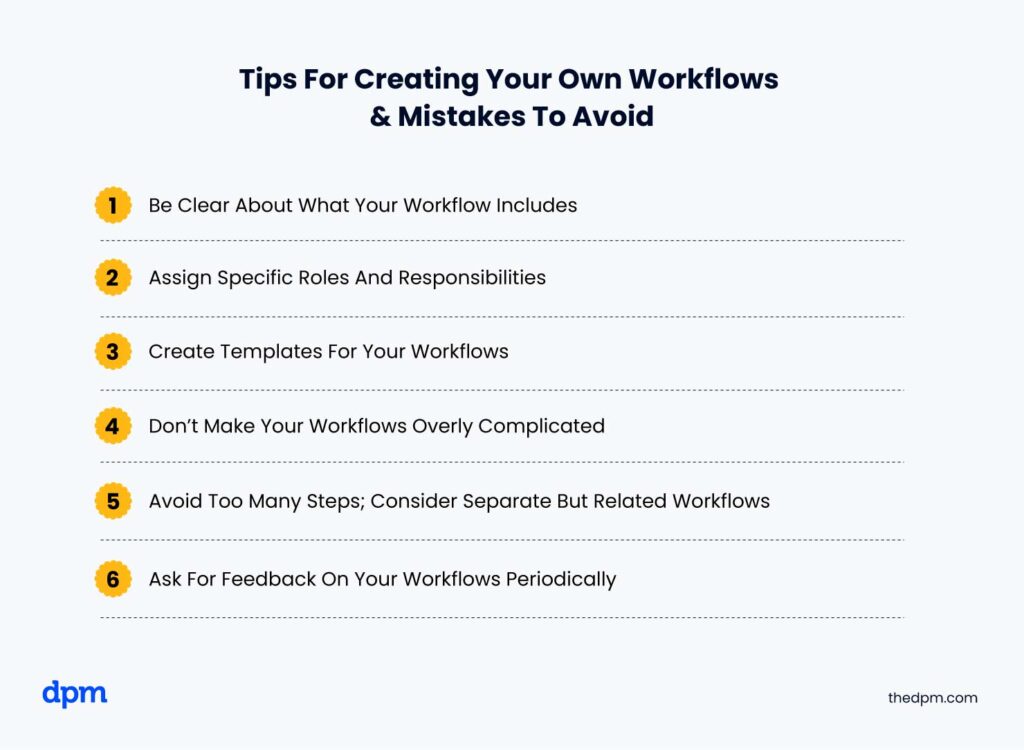As a project manager, you’re likely responsible for helping teams move through similar workflows many times over. For example, if you oversee the building of new websites, you might have workflows around creating scopes of work, kicking off the project, moving through design and development, launching, and providing post-launch support.
Having team members who work through these processes in different ways can cause challenges. If everyone works differently, how do you know if the work is progressing appropriately and will be completed on time and within budget?
Workflows are typically created and managed in workflow management software.
What Is A Workflow?
A workflow is a process divided into a repeatable series of steps or activities to complete the process or a series of tasks. For example, when creating a new website, the workflow process may involve designing the layout, writing the code, testing the site, and launching it live.
Using workflows, project managers can help keep projects on track and ensure that all tasks are completed as efficiently as possible.
Visual workflows make use of flowcharts or diagrams, and either show the process steps each work item will go through to be considered done or what the process looks like at a more macro-level, showing the stages of task completion or project completion overall.
Workflows differ from business processes in that they represent the specific, sequential tasks within broader processes that can help achieve organizational goals.
How To Create A Workflow

When creating a workflow, here are some things to keep in mind to ensure flawless execution.
1. Determine What Your Workflow Needs To Accomplish
The most important part of this step is to be very specific about what your workflow needs to accomplish. This is because it’s easy to make assumptions about what is or is not included in the workflow if you aren’t super specific and crystal clear.
For example, if you’re creating a workflow for writing blog posts, be specific and communicate whether that workflow is just for drafting the content or for drafting, creating supporting graphics, uploading and sharing on social media.
You might handle all of these steps within one workflow, or you may have separate workflows for creating and editing the content and uploading, publishing, and promoting it.
2. Identify Who Needs To Be Involved
Once you’ve decided exactly what your workflow will accomplish, the next step is to identify all of the people who need to be involved. In addition to assigning specific tasks in your workflow, you may also have people who need to review or approve the work at specific points in the process.
Defining this approval process is also a key part of creating the workflow, as not having this clearly defined can create bottlenecks or break your process.
One easy way to identify everyone who needs to be involved is to create and fill out a RACI diagram. You might not be able to do this until you’ve listed out all of the process steps (see step 3 below), but it’s a good idea to have this in place before launching your workflow.
3. List The Process Steps And Tasks That Need To Be Completed
The next step is to list the process steps and the tasks that need to be completed. This should be a step-by-step list of everything that should happen from the beginning of your workflow to the end.
Let’s use our blog example again. If our workflow is for publishing and promoting a blog post, here’s what it might look like (along with what marketing resources need to be involved):
- Choose the topic for your blog post (specify if there is a content calendar or list to pull from or if it’s okay to pick any topic)
- Get approval from the Marketing Director to proceed with that topic
- Write a content brief and content outline
- Provide creative direction and sizing for any images or illustrations needed
- Assign a writer to the blog post
- Assign a graphic designer to the blog post
- The writer creates the first draft of the blog post
- The graphic designer provides required images
- An editor reviews the blog post draft and images
- The writer makes copy edits
- The graphic designer makes edits to the images
- The editor approves the copy and images
- A marketing coordinator uploads the content to the website CMS
- The editor reviews and approves the post on the staging site
- The marketing coordinator sets the post live
- The copywriter shares a caption for social media
- The editor reviews and approves the caption
- The marketing coordinator posts the caption and link to the blog post on LinkedIn and Facebook.
4. Create A Workflow Diagram
Now that we have a workflow created, you might want to show this visually, using a workflow diagram. You can use a timeline view, Gantt chart, or workflow diagram software to show each step, who will do it, and even how long it will take.
Mapping workflows visually is a good way to streamline the communication about who will do what and when.
5. Test & Iterate On Your Workflow
Many times, specific workflows are good on paper but not so much in practice. This is why creating a workflow isn’t a one-and-done activity. You might find that you have repetitive tasks or redundancies or that you’ve skipped a critical step somewhere.
Testing a new workflow will give you real-time feedback about what’s working and what’s not. If the process breaks, takes too long, or is confusing, you’ll know from your test what you might want to troubleshoot for the next time.
Even if your workflow is executed successfully, you might find that you can continue to optimize it as everyone involved gets to practice using the workflow and working together.
6. Implement Your Workflow With The Broader Team
Once you’ve got your workflow tested and running smoothly, you can roll it out to the broader team. This might involve bringing in more stakeholders to run the workflow more efficiently or onboarding new team members to project teams that are going to use the workflow.
If you have a number of different types of workflows or the workflow is a new process, you might consider using your flowchart or a short tutorial to help people remember what happens and in what order.
Tips For Creating Your Own Workflows & Mistakes To Avoid

When you create workflows for your team, there are some things you want to ensure you do and others you may want to avoid. These include:
1. Be Clear About What Your Workflow Includes
I know I have said this one before, but it’s so important it’s worth repeating. The number one tip for successfully creating a workflow is to be extremely clear about what the workflow does and does not include.
If you need another example, consider email marketing. You may have one workflow for creating email copy, and another for designing the email layout and finally, a third workflow for sending the email and monitoring analytics. All of these workflows may need to run each and every time you send an email.
2. Assign Specific Roles And Responsibilities
Another important tip that bears repeating, but a few more things to note here:
When assigning roles or tasks ensure that each role or task is being completed by a single person. While it’s okay to ask someone to review work or contribute ideas, one person needs to own the task. If too many people are involved, the work never gets done because team members all assume someone else will do it.
So, if Jen, your marketing director, and Sam, who oversees the content team, should be putting together the content calendar and assigning writers to each piece, you want to break this task into two separate areas.
Jen should develop the content calendar, and Sam should review it and provide any feedback before assigning writers (that is one task for Jen and two for Sam).
If you work in a highly collaborative environment, that’s okay, but be clear about who owns the outcomes and empower them to seek input before marking a task complete.
3. Create Templates For Your Workflows
As you start to amass some workflows you use regularly, you can save time by building templates. In most popular project management software tools, you can build out entire projects with multiple workflows.
The more detail you can put into your templates, the easier it is to set up new projects and get people working.
Note that some workflows will need to be tweaked for specific projects. Maybe a timeline is being shortened because a client paid a rush fee or a stakeholder prioritized a specific deliverable - you want your template to be adjustable to accommodate these changes without creating fully custom workflows.
4. Don’t Make Your Workflows Overly Complicated
A workflow is only as good as people are using it! If you create a workflow that is so complicated no one knows everything that it entails, no one will know if it’s broken down.
This can happen if you use a lot of integrations and automation to run your workflow. While having these features can help you manage a complex workflow and save you time, ensuring everyone involved can understand the workflow is important.
5. Avoid Too Many Steps; Consider Separate But Related Workflows
Similar to the tip above, having workflows that have too many steps can become unwieldy to manage. This is why you might want to consider having related workflows. A good example of this might be onboarding a new employee. This is a pretty standard business process or workflow with a lot of people and steps involved.
In this case, you might have one workflow for human resources to handle all of the paperwork. This workflow might be followed by your internal IT person creating user accounts for all of your systems and tools like Slack, email, your project management tool, and any design, development, or creative software.
Another workflow you might need for a new hire is around meeting the team and training on internal processes. This could involve setting up schedules for the first day and first week.
As a project manager overseeing all of this, you might create a template for onboarding and add all of the related workflows that apply to the team member to their project.
Find more examples of workflows here.
6. Ask For Feedback On Your Workflows Periodically
We already discussed the need to test and iterate on new workflows, but this should extend to existing workflows as well.
You might want to check in with your teams periodically to ensure that your workflows are still meeting everyone’s needs. As processes change within your business, it may be necessary to look at how you configure your workflows and make adjustments to better support everyone’s needs.
If you are leveraging workflow templates, check to see if the team is updating their projects excessively and see if you can make any of those changes at the template level to save them time and effort.
Join Us For More Workflow Management Insights
If you’re looking for more insights into workflow management best practices, join our active community of project managers, where you can discuss workflows with other project managers like you.



